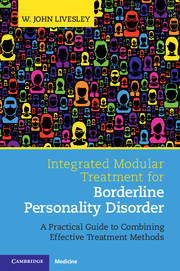 Integrated Modular Treatment for Borderline Personality Disorder
Integrated Modular Treatment for Borderline Personality Disorder Book contents
- Frontmatter
- Dedication
- Contents
- Preface
- Section 1 Introduction and Framework for Understanding Borderline Personality Disorder
- Section 2 Assessment and Treatment Planning
- Section 3 General Treatment Modules
- Section 4 Safety, Containment, and Engagement: The Initial Phase of Treatment
- Introduction
- 13 Managing Crises and Containing Emotions and Suicidality
- 14 Managing the Early Sessions
- Section 5 Improving Emotional Regulation and Modulation
- Section 6 Exploration and Change: Treating Interpersonal Problems
- Section 7 Constructing an Adaptive Sense of Self
- Section 8 Retrospect and Prospect
- References
- Index
13 - Managing Crises and Containing Emotions and Suicidality
from Section 4 - Safety, Containment, and Engagement: The Initial Phase of Treatment
Published online by Cambridge University Press: 16 February 2017
- Frontmatter
- Dedication
- Contents
- Preface
- Section 1 Introduction and Framework for Understanding Borderline Personality Disorder
- Section 2 Assessment and Treatment Planning
- Section 3 General Treatment Modules
- Section 4 Safety, Containment, and Engagement: The Initial Phase of Treatment
- Introduction
- 13 Managing Crises and Containing Emotions and Suicidality
- 14 Managing the Early Sessions
- Section 5 Improving Emotional Regulation and Modulation
- Section 6 Exploration and Change: Treating Interpersonal Problems
- Section 7 Constructing an Adaptive Sense of Self
- Section 8 Retrospect and Prospect
- References
- Index
Summary
Since most treatments begin with a crisis presentation and crises are common in the early stages of most treatments, therapists need to be skilled in managing crises and reducing their occurrence. This requires an understanding of crisis behaviour, the events that trigger crises, and how crises typically unfold.
Understanding Crises
Crisis Behaviour
Crises are characterized by emotional states that typically involve relatively undifferentiated emotional distress that escalates into a state of distress without resolution (see Chapter 4) which continues until it culminates in an urgent need to terminate the distress, which often results in deliberate self-injury. Escalation occurs because intense emotions overwhelm the cognitive mechanisms that regulate emotions and because maladaptive thoughts increase emotional arousal. Intense emotional arousal also impairs logical thinking, information processing, and problem-solving, making it difficult for patients to follow verbal interventions, instructions, or explanations. Consequently, interventions need to be kept simple and attempts should be made to align with the patient's distress and reflect an understanding of how the patient is feeling rather than attempting to confront the distress or address more complex matters. Unfortunately, the impact of intense emotions on thinking and information processing is not always recognized by those professionals who deal with these patients in crises.
As cognitive processes become more disorganized, other phenomena emerge such as transient psychotic symptoms and dissociative behaviour. Perceptual-cognitive symptoms occur in about 75 per cent of patients with borderline personality disorder (BPD). These usually take the form of quasi-psychotic symptoms such as pseudo-hallucinations, illusions, and ideas of reference, which include suspiciousness and mild paranoid ideation. Dissociative behaviour is also common, ranging from mild feelings of depersonalization and derealization to more pervasive dissociative episodes that may include decreased responsiveness. Impaired emotional control and thinking also contribute to behavioural disorganization. Besides the sense of urgency that leads to deliberate self-harm, coping skills become increasingly impaired, leading to regressive behaviour that sometimes progresses to the point that the individual cannot manage the routine tasks of everyday living. This occurred with Anna who sometimes took to her bed for several days because she felt overwhelmed and unable to cope.
- Type
- Chapter
- Information
- Integrated Modular Treatment for Borderline Personality DisorderA Practical Guide to Combining Effective Treatment Methods, pp. 135 - 144Publisher: Cambridge University PressPrint publication year: 2017
